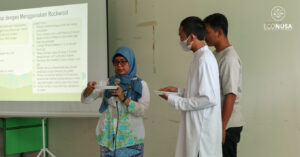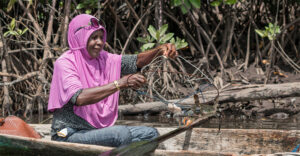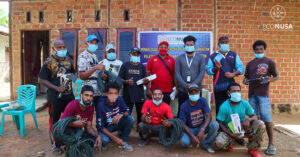
United States researcher, Jenna Jambeck, in 2015 launched the finding that Indonesia is the second largest contributor of plastic waste in the sea in the world. The results of this study were a blow to Indonesia, which led President Joko Widodo to formulate a strategic step to reduce 70 percent of plastic waste in the ocean by 2025.
In order to meet these targets, the Maritime Coordinating Ministry together with other relevant ministries established a National Action Plan that is regulated in Presidential Regulation (PP) No. 83 of 2018 concerning handling marine waste. The community also supported the effort, by initiating a number of actions.
Various awareness movements about the dangers of plastic waste, continue to be initiated by various social organizations. On the other hand, a number of Local Governments also made related regulations. When it is widely discussed by the public, this issue is able to gather new strength as support for efforts to reduce plastic waste.
The existence of plastic waste, especially disposable plastic in Indonesia is very worrying. This large amount of waste does not only damage the terrestrial environment, but also the waters of the archipelago. Garbage in the Indonesian sea is now a scourge of its own, as if haunting us in the form of monsters born from a collection of plastic.
Plastic monsters become a symbol for the movement to guard the Indonesian sea, from the threat of disposable plastic waste. Together with the Nusantara Sea Scout movement initiated by the Minister of Maritime Affairs and Fisheries (KKP) Susi Pudjiastuti, the EcoNusa Foundation Sea Program invites all parties to raise public awareness through the figure of a plastic monster. With the support of artists, the EcoNusa Foundation made this plastic monster a reality.
As much as 500 kilograms of disposable plastic waste netted from the Jakarta sea, is processed in such a way. After cleaning, the garbage in the form of packaging, bottles, straws and so on, is piled up to form the figure of a deep sea fish (angler fish) in a creepy form. A large body full of plastic, with a gaping mouth ready to swallow the earth.
Indonesian waters emergency plastic waste. This message is carried by the plastic monster to the wider community. Pandu Laut Nusantara brings plastic monsters to the Sunda Kelapa Harbor in Jakarta, as a form of appearance of the plastic monster from the sea (07/20/2019). A number of national influential figures, such as musicians Kaka and Ridho Slank, environmental activists Bustar Maitar and Tiza Mafira, and journalist Prita Laura participated in this campaign.
The symbolization of the existence of plastic waste in the form of plastic monsters has attracted the attention of many people, especially environmentalists. Social organizations and communities that focus on the issue of plastic waste, join the alliance care for the environment. As many as 49 organizations joined in it, voiced one to reject disposable plastics.
The amount of disposable plastic waste in the seas of Jakarta is very worrying. At least 7,452 tons of waste are produced every day in the nation’s capital. Data from the Ministry of Environment and Forestry (KLHK) together with the Indonesian Movement for Plastic Bags Diet (GIDKP) states that Jakarta contributes 2,000 tons of garbage per year. Thus, every day Jakarta residents face more than 3,600 plastic monster figures every day.
Not only as a symbol, the appearance of plastic monsters in Sunda Kelapa also strengthens public awareness about the dangers of disposable plastic waste. This plastic monster figure urges the government, especially the DKI Jakarta Regional Government, to issue a ban on the use of disposable plastic by industry. Innovations related to packaging materials to be environmentally friendly, also voiced by the community who work together to fight disposable plastic waste.









